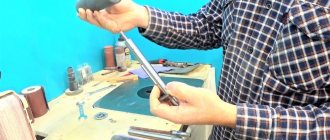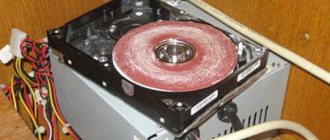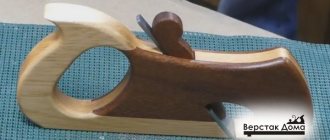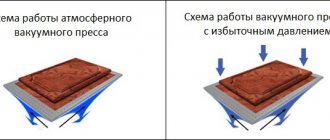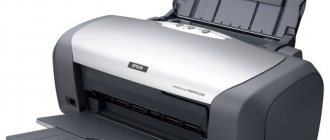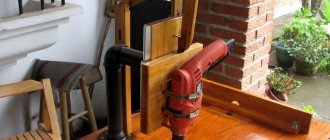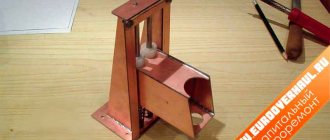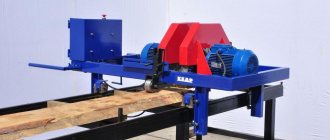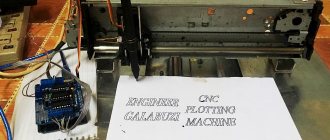A belt grinding machine is used in cases where it is necessary to perform finishing processing of parts, that is, as equipment for carrying out finishing technological operations. Most often, such machines are used in the furniture industry; they are used to process parts made from various types of wood. But a belt grinding machine can also be used to process metal parts, for which a belt with an appropriate abrasive material is used.
Belt grinding machine
Application areas of the machine
The main tasks performed by the belt grinding machine are: final leveling of the surface being processed, bringing the level of surface roughness to the required level, bringing the processed surfaces to the level of smoothness before covering them with varnish and other finishing materials. The belt machine is also used to eliminate minor defects of the processed surface: depressions, elevations and burrs, processing the finishing coating: removing sagging primer and varnish, burr, grinding internal surfaces, processing roundings on the surface of the part.
A factory-produced option, the drawings of which can be used to create a similar homemade device.
The tape machine can be used for processing parts made of various materials: wood, plain and alloy steel, non-ferrous metals. What’s convenient is that using a belt machine you can process parts that have different shapes: quadrangular, round and flat. Using such equipment, it is possible to process round and tubular parts with a large cross-sectional diameter.
Grinder: what is it and for what purposes is it used
This term refers to a grinding device used for processing metal (and other) parts. Machines that belong to this category are stationary. Their design includes an electric drive, due to which the working element is set in motion. This device is most often used for the following types of work:
Most often, the grinder is used for metal processing, but can also be used for grinding wood and glass.
- grinding;
- sharpening;
- rust removal;
- elimination of burrs.
Many home craftsmen use similar equipment to sharpen knives. The efficiency of this device is very high, so for such a simple task you can take an inexpensive model of the unit. Many experts do not advise buying a machine of this type to perform one task, since it is extremely unprofitable. Before purchasing a specific model, it is recommended to study reviews about it. Grinders located in the lower price segment may be ineffective, so it is not recommended to save much on such a purchase.
Using a grinder, you can bring a metal surface to the desired state: polish it, eliminate various defects, and also remove unnecessary sharp edges. The cost of such devices averages 17 thousand rubles, which is quite expensive. As a result, many people decide to assemble such a device with their own hands. The design of a belt grinder is very similar to a manual sander. The drive, which is a key element of the device, drives a pulley, which is equipped with an abrasive belt.
What else can this type of machine be used for? In addition to processing metal cutting tools, such a unit can be used to grind products made from other materials. For example, it is often used to process parts made of stone and glass. If desired, you can use a grinder to smooth the edge of glass or sand wood.
The device is suitable for sharpening, grinding, removing rust and burrs
This tabletop machine allows you to remove a layer of rust, paint or varnish, which is also considered a very useful property. In addition, you can do it yourself. A drawing of a homemade grinder can be found on any specialized forum. Such a machine is the most effective solution if there is a need to grind a metal pipe, align the edges of parts, and also sharpen them.
Design features of the machine
The working tool of any belt surface grinding machine is a belt on the surface of which abrasive powder is applied. It is made in the form of a ring and is placed between two rotating drums, one of which is the leading one and the second is the driven one.
Recommendations for the direction of rotation of the machine belt
Rotation to the drive shaft of the tape machine is transmitted from an electric motor, which is connected to it via a belt drive. The speed of movement of the belt mechanism can be adjusted, thereby changing the processing modes of parts. The belt of a surface grinding machine can be positioned horizontally or vertically, as well as at a certain angle, which is allowed by some models of equipment in this category.
When choosing a belt sanding machine model for processing a particular part, it is important to consider the length of the surface that needs to be sanded. It is much more convenient to process parts on such machines whose surface length is shorter than the length of the abrasive belt and work table. If such conditions are met, the quality of processing will be much higher.
A homemade version of the machine is not so difficult to implement in a home workshop
The belt grinding machine can have different designs: with a movable and fixed work table, with a free belt. A separate category includes wide-belt equipment, the peculiarity of which is that their work table, which is also a feed element, is made in the shape of a caterpillar. In those equipment models that have a work table in their design, the abrasive belt is located in a horizontal plane, and in equipment with a free belt that does not have a work table, it can have a different spatial position.
A mandatory structural element of any belt sanding machine, including a tabletop one, is an exhaust device, which is necessary to remove dust generated in large quantities during the processing process. Both a professional and any homemade grinding machine used in a home workshop or garage are powered by an electric motor.
Construction of a homemade belt sanding machine
Grinding machine device.
The main parts of the machine are as follows:
- A motor or motor-driven engine powered by electricity. It is better to install the drive next to the main diameter drive roller.
- Base or bed. It is often fixed directly on the floor, sometimes this thing rides on wheels - whatever is more convenient and necessary for you.
- Two tension rollers - driving and driven. Make of metal or very durable wood with a thin layer of cushioning rubber to prevent the tape from slipping onto the rollers or drum.
- Spring and lever for the belt tension system. The spring is pressed, and the lever is attached to the base and driven roller.
- Base for placing a motor with a drive.
- For abrasive tape you need to use paper or cloth. Its width can be very different - in the range from 5 to 30 cm. Grit level - from 80.
- Metal pipes with a thickness of 2 mm or more.
- Metal corners in accordance with the dimensions of the machine.
- Special magnetic stand for metal parts.
- Rail type guides.
https://youtu.be/GwylmVI7PG8
Diagram of the grinding machine.
Stages of work:
- We make the frame of the base or bed. — we cut the corners according to the dimensions of the bed; — We weld the frame and corners; — we fix a chipboard board at the bottom of the frame to reduce vibration during operation.
- Making a work surface. — cut a steel sheet to size and weld it directly to the base; — weld the rail guides to the top of the frame; — we make a carriage from corners with wheels for moving along the guides of the bed; — on both sides of the working surface we mount and fix bearing supports; — fix the screw with the handle on the carriage;
- We fix the electric motor to the working area lifting system.
- We fix the gear supports.
- We install a tape with an abrasive coating. — cut the tape with a margin of a few centimeters at an angle of 45°; — we glue it together with an overlap and coat the sides with glue with the abrasive washed off with water; — dry the gluing area with a hairdryer;
- We are preparing for a test launch of the machine. — we treat all machine parts with machine oil; — supply electrical power; - We do a trial run.
Principle of operation
The main operating parameters of a belt sanding machine include the feed speed and the force with which the belt is pressed against the workpiece. Parameters such as the degree of grain size of the abrasive belt should be selected depending on the material from which the workpiece is made, as well as the degree of roughness that the surface of the machined product should have.
The characteristics of the material being processed, in particular its hardness, primarily influence the grit size of the abrasive belt to be selected. Processing modes that are directly related to each other are feed speed and tape clamping force. So, if grinding is carried out at high speed, but with insignificant pressing force of the abrasive belt, then some areas of the surface of the part may turn out to be untreated. If, on the contrary, you increase the clamping force and reduce the feed speed, you may encounter the fact that burns and blackening of the material may appear in certain areas of the surface being processed.
Another variation of the machine - view from the working surface of the belt
The results of grinding are also influenced by how well the abrasive tape is glued together. In order to obtain high quality processing and not encounter malfunctions in the operation of the belt machine, you should not use abrasive belts that are glued incorrectly or have torn edges. When putting the tape on the equipment shafts, it should be positioned so that the overlapping end of the seam does not ride up against the surface of the workpiece, but slides along it. Learn more about gluing tape in the video below.
Any, including a manual grinding machine, must provide the ability to adjust the belt tension, which is ensured by moving a movable shaft that is not driven. Tape tension is a very important parameter, when choosing which you should follow the “golden mean” rule. If the sanding machine belt is pulled too tightly, this can lead to its rupture during operation, and if its tension is too weak, it will cause slippage and, as a result, excessive heating. The main characteristic for determining the degree of tension of the tape is its deflection, which is measured by lightly pressing on its surface in a tense state.
A manual belt grinding machine can be serviced by one operator, who moves the work table with the workpiece and rotates it so as to bring all areas of its surface under the abrasive belt.
Safety precautions when working on a sanding grinder
Like any other work on any other machines, grinding on a homemade belt sanding machine is subject to fairly strict safety rules that must be strictly adhered to.
The principle of operation of the grinder.
These rules are as follows:
- It is strictly forbidden to touch anything that moves with your hands while the machine and working surface are operating.
- Wear safety glasses while working to protect against hot abrasive particles.
- Carefully check that the connections and fastenings of all moving parts of the grinder are tight.
- Monitor the condition of the braiding of electrical wires.
- A protective casing is a must, even though it slightly narrows the viewing angle.
Electrical equipment, light, lighting
0 votes
+
Vote for!
—
Vote against!
When carrying out construction and repair work, men often need to process wood, stone or metal. For quality work, it is advisable to purchase a belt sanding machine. But what to do when finances do not allow you to make such a purchase? To do this, it is enough to build a belt sanding machine with your own hands.
Purpose of a belt sanding machine
Wood is widely used in a wide variety of manufacturing organizations. Many different parts and products are made from wood. In order to properly process a wooden blank and give it the appearance of a finished product, it is customary to use various equipment, including belt sanders.
Belt grinding equipment is typically used in the final stages of production, when parts are subjected to finishing machining. Such devices are convenient to use in the production of furniture and various consumer wood products. Depending on the material used, belt sanders work with wood or metal.
The main purposes of using wood grinding machines are the final leveling of the surface, bringing their roughness level to the required value, obtaining even and smooth surfaces of wood products and wood materials before veneering or after coating with varnish and other finishing materials, removing local irregularities in the form of depressions and elevations, removing burrs and removing local deposits of varnish and primer, removing burrs, internal grinding and grinding of curves.
Belt grinding machines for metal work with various materials and formats that are common in metalworking: plain and alloy steel, non-ferrous metals in the form of quadrangular, round and flat workpieces. Grinding machines allow you to grind round timber and large diameter pipes efficiently and with minimal time.
Depending on the type of processing and type of feed, belt grinding machines are intended for:
- for grinding curved surfaces with a free sanding belt;
- for processing a flat surface with a fixed table, manual movement of the iron and table, as well as mechanized movement of the work table and manual movement of the iron;
- for processing panel and block parts, their ends and side edges;
- for intermediate sanding of paintwork.
Belt Sanding Machine Design
Belt grinding machines are produced by modern foreign and domestic manufacturers in a wide range. Grinding machine prices vary widely. They also differ in possible performance and design. However, they also have something in common. They are united by the fact that absolutely all machines have an abrasive belt as a working element, which is most often connected into a ring and placed between rotating drums.
One drum is the leader and the other is the slave. This means that the first of them is equipped with a mechanical transmission, which is most often based on a belt drive, through which torque is transmitted to it from an electric motor. Any belt sanding machine is designed in such a way that the speed of movement of the drive drum, and therefore the speed of movement of the abrasive belt, can be changed, providing different modes of surface treatment.
The abrasive belt can be positioned vertically or horizontally. In addition, equipment modifications are available for sale in which the working element is installed at a certain angle. The abrasive belt is mounted on a frame, on which the workpieces are usually located. Workpieces can be held by the operator manually or with the help of special devices that make the work easier for consumers and make the processing procedure more efficient and safe.
The machine table is made of metal sheets or thick boards. If the design provides for the table to be made of metal, then it will be possible to sharpen more complex products. The length of the working part of the belt grinding machine and the grinding belt itself primarily depends on the length of the products that will be sanded on the machine.
If the part has a shorter length than the working surface of the machine, then it will be much more convenient to process, and the processing will be of higher quality. For example, with a sanding belt length of 4.5 meters, you can easily process wooden workpieces that are 200 centimeters long.
Belt grinding machines are divided into equipment with a fixed and movable work table and devices with a free belt. A special group is wide-belt grinding machines, in which the caterpillar-shaped table is also a feeder. For machines with tables, the belt is placed horizontally; for designs with a free belt, it is installed in different ways.
Since the grinding process inevitably generates a lot of dust, all belt grinding machines are usually equipped with special powerful hoods that remove most of it during the technological process itself. Grinding machines are powered by an electric motor, which has a power of about 2.8 kilowatts. With a high-power motor, the normal speed of the belt reaches 20 meters per second.
Abrasive belts for grinding machines
The cutting tool of belt grinding machines is a sanding belt, which consists of a fabric or paper base and abrasive grains that are attached to it using adhesives. Abrasive belts are manufactured using two methods: mechanical and electrical. The first method consists of uniformly pouring abrasive grains onto a base that is covered with glue, and the second method occurs in an electric field, which orients the grains upward with their sharpest edges to improve the cutting properties of the grinder.
Abrasive grains are poured onto the base in a bundle tightly or sparsely. The most effective is considered to be an abrasive belt with a sparse backfill, when the grains occupy less than 70% of the area, because wood dust generated during the grinding process is not able to get clogged between their grains. Natural minerals or artificial materials that have high hardness, for example, green and black silicon carbide, white and normal monocorundum, as well as normal electrocorundum, can be used as abrasive materials.
For the purpose of gluing grains, synthetic resins and hide glue are used. As a base, fabric such as calico and twill, or special grade paper is used. The size of the abrasive grains is indicated by a number that corresponds to the size of the sieve cells in which these grains are retained, and is displayed in hundredths of a millimeter.
If you are interested in how to make a belt sanding machine, then you should pay attention to the following sizes of grinding powders and abrasive grains and their classification: grinding grain - from 2000 to 160 microns, grinding powders - from 125 to 40 microns; micropowders - from 60 to 14 microns, very fine micropowders - from 10 to 3 microns.
Sanding paper is supplied to woodworking enterprises in sheets or rolls. On the non-working surface of the skin there is a marking with the specified characteristics of the skin and the manufacturer. For a belt sanding machine, skins are used in rolls and cut into strips of a certain length and width. The length of the cutting tool is determined depending on the method of its connection - lap or butt at an angle.
The ends are cut off when gluing end-to-end at an angle of 45 degrees and then glued onto a canvas lining with a width of 80 to 200 millimeters. At one end of the tape, when gluing with an overlap, the abrasive grains are removed with hot water over a distance of 80 to 100 millimeters, then the other end of the tape is applied to the exposed base lubricated with glue. Compress the joined ends and dry them using a special device or a size press.
Sheet sandpaper is used for combined belt-grinding machines. For grinding discs, it is customary to cut the sandpaper in the form of a circle according to a template, the diameter of which is 60 - 80 millimeters larger than the diameter of the disc. Using a rectangular template, blanks are cut for the reel. After cutting, they have smooth edges without tears. The presence of unglued ends or seals when gluing tapes can cause premature rupture of the tape.
The skin is cut into sheets using wide-belt sanding machines according to a template made of plywood or aluminum sheet. The skin is cut in such a way that the edges are smooth and the difference in the length of the side edges is no more than 1 millimeter. One of the beveled edges is cleaned, removing abrasive to a width of 20 millimeters. The cleaned edge and longitudinal edges are covered with a strip of tracing paper, 40 millimeters wide, which protrudes beyond the edge of the sandpaper by about 10 millimeters.
Lubricate the beveled edge with tracing paper with glue and leave it in the air, depending on the viscosity and type of glue. Then the beveled edges are joined and a strip of sandpaper is applied to the joint, the joint is compressed and held in a press. It is customary to hang finished endless belts on special brackets and keep them for at least a day in a dry room before installing them on a grinding machine.
Operating principle of a belt grinding machine
A belt sanding machine consists of a table top with a work table for mounting the cutting tool. This table is fixed in different positions relative to the tabletop. The material for the tabletop is usually laminated chipboard with a thickness of 25 millimeters. The worktable on rollers is moved manually or laterally by a mechanical drive along round guides that are attached to supports.
Above the table there is a working belt mounted on non-drive and drive pulleys. The sanding belt is tensioned and adjusted using a screw device with a pneumatic cylinder. Double belt sanders have two identical sanding tools that are placed in series on a bed and have sanding belts that move towards each other.
Grinding is carried out by the transverse movement of the work table and the longitudinal movement of a short iron, which presses the belt to the material being processed. The sanding belts are driven by an electric motor via a belt drive. The waste generated during grinding is collected by a dust collector, which is connected to the exhaust network.
When assigning a grinding mode, it is recommended to select the grain size of the sandpaper, the feed speed and the pressing force of the belt to the product based on the specific roughness and properties of the material being processed. The grain size of the skin is usually chosen depending on the hardness of the materials being processed and the required surface roughness. The clamping force and feed speed are interdependent quantities. With little force and high feed speed, some areas of the surface may not be sanded; with high pressure and low feed, burns and blackening of the material are possible.
Before installing the tape, check the quality of its gluing. Do not use incorrectly glued or torn sanding belts with uneven edges. Using the handwheel, you can reduce the distance between the pulleys and put on the belt. The gluing area is placed so that the outer end of the seam on the abrasive side is directed against the working movement of the sanding belt.
The belt tension can be adjusted by moving the tension roller for the belt grinder or the non-drive pulley. It is not advisable to tighten the tape too much, as this will cause it to break. But the sanding belt, with low tension, slips along the pulleys and heats up very quickly. The tension force is set depending on the strength of the base of the cutting tool and is determined by the arrow of its deflection with slight pressure on it.
How correctly the belt runs can be checked by turning the pulley manually or briefly turning on the electric motor. When the belt slips, the pulley axis is turned by a handle at a small angle and secured with a locking device. After setting up the belt grinding machine, the dust suction system is turned on, a trial processing of the parts is carried out and their quality is checked.
A manual feed belt grinder can be operated by one worker. By moving the product relative to the cutting tool in the longitudinal direction and rotating the part around its axis, the operator sequentially brings into contact with the tape all areas that form the surface to be processed. If you slow down or move carelessly, sanding may occur.
It is customary to grind individual sections of a part in several passes. High-quality leveling can be achieved by properly regulating the pressure applied to the handle of the iron and the speed of movement of the table and iron. The pressure must be reduced as you approach the edges to prevent them from being sanded off. To increase the quality and productivity of grinding, small bars are placed on the table in a row, several pieces at a time.
Belt grinding machines with mechanical feed of products are serviced by two operators. One of them places the part on the conveyor, orients it along the width of the work table and directs the product under the clamping elements of the machine. When being picked up by a conveyor, parts must not be moved laterally.
It is not allowed to feed into the machine workpieces that have unequal thickness and parts with gross surface defects. The feed rate and pressure of the clamping beam, as a rule, are not regulated during processing. The second operator receives finished parts and ensures that unacceptable edge rounding and sanding does not occur.
Making a Belt Sanding Machine
The price of belt grinding machines from an industrial manufacturer is quite high, so when they are used infrequently, craftsmen involuntarily think about whether to buy the equipment or not. An alternative to buying an expensive machine is to assemble it yourself. The main parts of the machine are the frame, rollers and engine.
The motor can be removed from an old washing machine. Cut the frame from thick iron measuring 500 by 180 by 20 millimeters. Cut one side evenly on a metal milling machine; it is required for attaching the platform with the motor. The dimensions of the working platform are approximately 180 by 160 by 10 millimeters. Make markings and drill three holes in the end of the evenly cut frame. It is necessary to tighten the platform to the frame with three bolts.
Remember that the longer the work table is, the more options you will have when choosing a technological method for grinding and processing the product. If the length of the workpiece is less than or equal to the length of the work table, then you can achieve a perfect grind much easier than when moving a large workpiece.
The engine must be placed tightly on the frame. It should have a power of approximately 2.5-3.0 kW and a rpm of about 1500. If you choose a sanding belt speed of approximately 20 m/s, then the diameter of the drums should be about 200 millimeters. Thus, if the engine speed is sufficient, a gearbox for the grinding machine is not required.
One of the two drums will play the role of a drive drum, which should be firmly fixed to the engine shaft, and the other tension drum should rotate freely around a fixed axis on bearings. The table on the side of the driven drum should have a certain bevel, which will ensure smooth contact of the sanding belt with the surface of the work table, this is especially true for a glued joint.
You can make a tension drum and a drum that guides the sanding belt from chipboard. To do this, you need to cut blanks from the slab with overall dimensions of 200 by 200 millimeters and assemble a package of 240 millimeters from them. Square tiles or a package of them should be folded on an axis and machined to a diameter of about 200 millimeters.
Remember that in the center the diameter of the drum should be 2-3 millimeters larger than at the edges. With a similar surface geometry, the flexible sanding belt will be located in the middle of the drum. The optimal tape width is 200 millimeters. From a roll of emery cloth that is 1 meter wide, you can easily glue 5 similar tapes together.
The cutting tool must be glued end-to-end, with a thin, dense material, for example, a tarpaulin, placed underneath. It is recommended to use the highest quality glue you can get. Be sure to stretch rubber onto the rollers, the width of which reaches 30 millimeters. Rubber can be taken from the inner tubes of a moped or bicycle.
On a homemade belt sanding machine, in addition to grinding wooden products, for which it is actually intended, it is very convenient to sharpen tools with cutting surfaces - chisels, knives, axes, pruners. Another advantage of this grinding machine is the ability to work with parts that have a curved surface - to do this, you need to grind the workpiece with the back side of the working belt.
Grinder design diagram
The difference between a belt grinder and conventional grinding machines is that it uses a sanding belt rather than a disc for processing. This allows you to select the desired degree of grain size and process large areas.
The abrasive tire installed in the tensioner moves by rotating the drive shaft. Grinding is performed when the surfaces of the part and the moving tire come into contact.
Grinder scheme.
The design of grinders does not differ from the design of stationary disk machines. Essential elements:
- Drum system. Designed for mounting a tire. Consists of drive and several driven shafts.
- Bed . The design of the element depends on the purpose for a specific type of material being processed. For wood, a lightweight frame is used, for metal – a more powerful one.
- Tension system. Used to maintain the tire in a constantly tensioned position.
- Electrical unit consisting of an electric motor and a control unit. As an additional element, a speed increase/reduction unit based on a belt drive is included.
Machines for making and sharpening knives
If in ancient times the process of creating a knife took a long time, now thanks to technological progress and automation everything happens hundreds of times faster. Previously, a person was forced to do everything manually: from pouring the workpiece to sharpening and polishing.
Now, with the use of various machines, finished metal with the necessary characteristics, holders and tools, the master does not need to put in a lot of effort.
You can make a knife with your own hands both for yourself and for sale. In any case, it is necessary to acquire a number of equipment to maximize production productivity:
- grinder with discs;
- drill or screwdriver;
- grinder;
- engraver with different attachments;
- grinder (grinding machine);
- electric jigsaw;
- band-saw.
This list can be supplemented by less necessary machines (you can do without them), holders that will help speed up the process at certain stages. If you need to create a knife with a more complex, unusual design, you will need other devices, since a standard set is not enough.
I would like to pay special attention to such an important device for knife makers as a grinder. It is with its help that you can make knives at home that are no worse than store-bought ones. It will help give the bladed weapon a factory look.
Rotary table for grinder
Without a table, the grinder will not be able to process complex parts. The rotating mechanism with the ability to fix the part provides many advantages and allows for precise processing.
This device is made of duralumin. A bracket is attached to it so that the table can rotate horizontally.
The thickness of the duralumin sheet is at least 1.5 cm. A thin sheet may not withstand the load.
Previous
KnivesRubber training knife
Next
KnivesHow to make a knife stand with your own hands at home
How to make a grinder at home
If we describe the design of the grinder quite simply, then it is a motor, 2-4 rotating rollers, one of which is adjustable, and a sanding belt. A grinder is usually distinguished from a manual grinder by a fixing stand with the ability to change the angle of inclination.
The stand is necessary for precision work. We decided to make descents - fix it, set the desired angle of inclination of the stand and start the grinder.
As for the adjustable roller, it is a must. After all, the sanding belt stretches over time, and subsidence forms. The roller is pulled up and the work continues. There is another important point: sanding tape is suitable only on an elastic basis. Otherwise, it will break under the load.
To assemble the machine at home, you will need:
- Think over the design of the device and make drawings.
- Prepare all the necessary tools: jigsaw, drill, ShMU.
- Prepare the parts required during the assembly process or arrange with a turner for turning them.
First you need to decide on the tape, or rather its length. For domestic use, the optimal option is 915 mm; this is the length with which the majority of Chapaevsky machines work.
The base for the bed must be more than 12 mm thick. Bolted connections in this situation are unreliable. It is advisable to use welding.
When turning rollers, the roughness index is important, which should be at least 1.25. Otherwise, the tape will wear out quickly. If the machine is planned to be made with four rollers, then it is customary to use the following dimensions: 150 mm for the leading one, 100 mm for the adjustable one, and 70 mm for the remaining one. It is important to position them without distortions to avoid the tape slipping.
The cost of a finished pulley starts from 2000 rubles. Somewhat cheaper you can order from private turners.
Grinder made by yourself.
Particular attention should be paid to the drive for the grinder. If it is not possible to acquire a specialized engine, you can use an alternative. It is advisable to use an engine with a power of 0.75 kW or higher, and a speed of 1,200 or more.
Homemade grinder with a washing machine engine
With a drive pulley size of 70÷100 mm, the motor for the grinder must spin up to at least 3000 rpm. The motor, removed from an old automatic washing machine, has low power (below 300 W). It is characterized by good reliability and is unpretentious in operation.
The popularity of using just such a drive is due to its wide distribution.
The drive from the washing machine must be included in the preliminary drawing. A do-it-yourself grinder at home requires a motor with an output shaft. In this case, the shaft has a threaded connection, the design of which allows it to be connected to the pulley without much difficulty.
From a drill
A grinder for a drill is a special attachment that can be made in several stages. There are hundreds of different manufacturing options. Let's consider one of the simplest and most reliable, step-by-step instructions:
- Everything necessary for work is prepared: shaft with gears, bearings and sheet metal.
- Two plates measuring 110x250 mm are cut out.
- The necessary holes are drilled on each of the plates. In this part the bearings will be fed for adjustment.
- Next, take a “hairpin” and cut it into 120 mm pieces. Homemade rollers are installed on studs and secured with bolts. The tape is stretched and fixed on the other side.
- A base is made for attaching the grinder. The machine is mounted on the bed, and the drill is fixed with clamps.
- A corner is sharpened and attached for convenient fixation of the knife during sharpening.
From the Bulgarian
The main design difference between an angle grinder and other types of power tools is that its output shaft is turned at an angle of 90º to the axis of the electric motor and, accordingly, to the housing. For this reason, it is called an angle grinder.
This feature is perfect for longitudinal fastening of the drive roller and the “electric file” blade. The result is a tool that is elongated in a line and very comfortable to use. The same attachment for a drill is located at a right angle to the body, which is quite inconvenient for work.
To make a device, it is enough to make a metal base for the rollers, tension the tape, and adjust the dimensions of the drive roller to the ShMU guide, and the machine is ready.
The main types of grinder rollers
In the design of modern stationary electrically driven devices, an important place is given to rollers or rollers. They are driven by a motor. A belt with an abrasive layer for grinding workpieces is passed through them. As a result, the belt moves, which makes it possible to work with such a machine.
Rollers or rollers for grinders are primary and secondary
The output shaft, which is a structural element of the electronic motor, is connected to the drive roller of the drive device. All this is indicated in detail in the grinder drawings, which can be found on the Internet. The rotation created by the engine passes to the driving and then to the auxiliary (driven) rollers. Thus, there are only two types of rollers: primary and secondary.
The position of the auxiliary rollers can be adjusted, which allows you to control the grinding depth. The tension mechanism, which is a compensatory system, is located on one of the rollers. It is because of this that this roller is called a tension roller. If one such element fails, you can make it yourself. Do-it-yourself grinder rollers can be made from available materials, but the cost of replacing them is not so high.
The rollers of the drive table unit used for grinding and sharpening are important design elements. Their function is to hold and evenly distribute the tension of the abrasive belt.
Bed dimensions and table angle
The unit is installed on the table surface and secured with bolts. Before installation, you need to clarify the following parameters:
- the tilt angle is 30-50°;
- Dimensions of the frame: length 400 mm, width 300-400 mm.
The convenience of performing operations depends on these parameters.
The equipment can be equipped with a spark arrestor, a belt guard, a position regulator, and a tilt locking handle.
The switch is also equipped with a lock. This is necessary to ensure reliable overload protection. All of the above is evidence of the functionality of the device. To work effectively, the operator must be confident in safety while working.
Belt grinder: main advantages and disadvantages
Any equipment used in home or professional workshops has its pros and cons. Such machines are also no exception to the rule. The first and perhaps most significant advantage of the grinder is its versatility. Some models can be used for a large number of tasks, for example, like the grinder from Chapai.
Another advantage of such equipment is a consequence of its design. The point is that during grinding the working area does not overheat. An increase in temperature is a drawback common to most grinding units. Moderate heating is achieved due to the dimensions of the working element (pulley). The dimensions of the circle contribute to its cooling when moving outside the operating point.
All surfaces of such a tabletop machine are polished, which is also considered a serious advantage. This characteristic makes its operation as simple and convenient as possible. Belt grinders have a smooth operation, which allows you to evenly process metal parts and products made from other materials.
The main advantage of a belt grinder is its versatility
Industrially manufactured equipment is distinguished by high precision in the location of the rollers. Due to this, the likelihood of distortion of the abrasive belt as the pulley moves around its axis is reduced.
The downside of any factory grinder, of course, is its cost, which is far from affordable. However, today it is possible to purchase a prefabricated kit, which includes all the necessary parts (except the engine). One of the most popular sets is the Mastak belt grinder, the price of which is only 7 thousand rubles.
And finally, it is worth noting the special design of the pressure pad. Tabletop machines of this type are designed for processing parts that differ not only in material, but also in shape.
